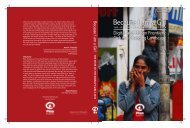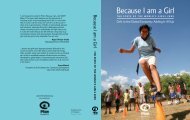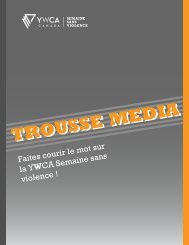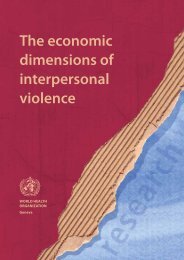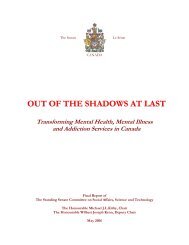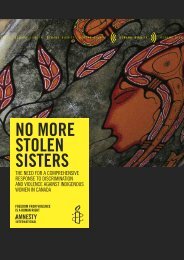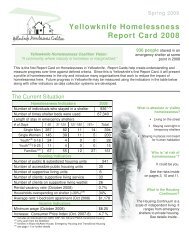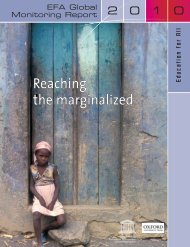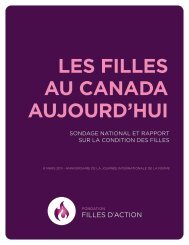Gender Report Card on the International Criminal ... - YWCA Canada
Gender Report Card on the International Criminal ... - YWCA Canada
Gender Report Card on the International Criminal ... - YWCA Canada
Create successful ePaper yourself
Turn your PDF publications into a flip-book with our unique Google optimized e-Paper software.
Structures & Instituti<strong>on</strong>al Development Structures<br />
Overview of Trends CONTINUED<br />
Office of Public Counsel<br />
for Victims<br />
As of 14 October 2011, <strong>the</strong> Office of <strong>the</strong><br />
Public Counsel for Victims (OPCV) assisted<br />
2,119 applicants and victims admitted by <strong>the</strong><br />
Chambers to participate in proceedings – a 69%<br />
increase from 2010. While victims from CAR still<br />
c<strong>on</strong>stitute <strong>the</strong> majority of those represented or<br />
assisted by <strong>the</strong> OPCV (1,011), <strong>the</strong>ir percentage<br />
against <strong>the</strong> total number decreased by 36%<br />
(from 84% in 2010 to 48% in 2011). This year, <strong>the</strong><br />
DRC Situati<strong>on</strong> has <strong>the</strong> sec<strong>on</strong>d highest number<br />
of victims represented and assisted by <strong>the</strong> Office<br />
with 748 (35%). Victims in <strong>the</strong> Uganda and<br />
Darfur Situati<strong>on</strong>s are respectively 6% and 1% of<br />
<strong>the</strong> total. This year <strong>the</strong> OPCV also supported 222<br />
victims from <strong>the</strong> Kenya Situati<strong>on</strong> representing<br />
10% of <strong>the</strong> total number of victims assisted.<br />
Overall, across all Situati<strong>on</strong>s, male victims are<br />
<strong>the</strong> majority of those represented or assisted by<br />
<strong>the</strong> OPCV (63.5% of <strong>the</strong> total, 1.5% more than in<br />
2010). Men are also <strong>the</strong> majority of applicants<br />
and recognised victims in every Situati<strong>on</strong> and<br />
case. As in 2010, Sudan has <strong>the</strong> highest male/<br />
female differential (72% difference). While last<br />
year 44% of DRC victims assisted by <strong>the</strong> OPCV<br />
were women, this year <strong>the</strong> figure is 30%. This<br />
indicates that <strong>the</strong> significant increase in <strong>the</strong><br />
number of victims assisted and represented by<br />
<strong>the</strong> OPCV in relati<strong>on</strong> to <strong>the</strong> Situati<strong>on</strong> in <strong>the</strong> DRC<br />
(from 63 in 2010 to 748 in 2011) has primarily<br />
involved male victims. While female victims<br />
assisted and represented by <strong>the</strong> Office in relati<strong>on</strong><br />
to <strong>the</strong> Situati<strong>on</strong> in <strong>the</strong> DRC are eight times more<br />
than in 2010 (28 in 2010 and 225 in 2011), male<br />
victims are 15 times more than in 2010 (35<br />
in 2010 and 523 in 2011). In 2011, 42% of <strong>the</strong><br />
victims from CAR are women compared with<br />
39% last year.<br />
<str<strong>on</strong>g>Gender</str<strong>on</strong>g>-based crimes were reported by 70%<br />
of <strong>the</strong> female victims from CAR being assisted<br />
by <strong>the</strong> OPCV. In DRC and Uganda, 10% of female<br />
victims reported crimes of sexual violence and<br />
rape. In Kenya, 15% of female victims reported<br />
sexualised crimes. With <strong>the</strong> excepti<strong>on</strong> of Kenya<br />
for which this figure was not available in 2010,<br />
<strong>the</strong> percentages of female victims reporting rape<br />
and sexual violence in <strong>the</strong> different Situati<strong>on</strong>s<br />
are <strong>the</strong> same as in 2010. 253<br />
There are nine professi<strong>on</strong>al and <strong>on</strong>e general<br />
service posts within <strong>the</strong> OPCV, n<strong>on</strong>e of which<br />
is vacant. While in 2010 women comprised<br />
<strong>the</strong> majority of staff and occupied all <strong>the</strong> three<br />
senior posts (<strong>on</strong>e P5 and two P4), this year<br />
women occupy four out of <strong>the</strong> nine professi<strong>on</strong>al<br />
posts and two out of three senior posts (<strong>on</strong>e P5<br />
and <strong>on</strong>e P4). This year, GRULAC is not represented<br />
in <strong>the</strong> Office and 50% of <strong>the</strong> 10 staff members<br />
are from WEOG. In 2010, all <strong>the</strong> regi<strong>on</strong>s were<br />
represented in <strong>the</strong> Office and WEOG appointees<br />
were three out of <strong>the</strong> nine filled posts.<br />
253 This year, no informati<strong>on</strong> about <strong>the</strong> number of victims<br />
represented and assisted by <strong>the</strong> OPCV by Case, <strong>the</strong>ir<br />
gender breakdown, and <strong>the</strong> type of crimes reported by<br />
Situati<strong>on</strong> and by Case was made available to <strong>the</strong> Women’s<br />
Initiatives for <str<strong>on</strong>g>Gender</str<strong>on</strong>g> Justice.<br />
62





